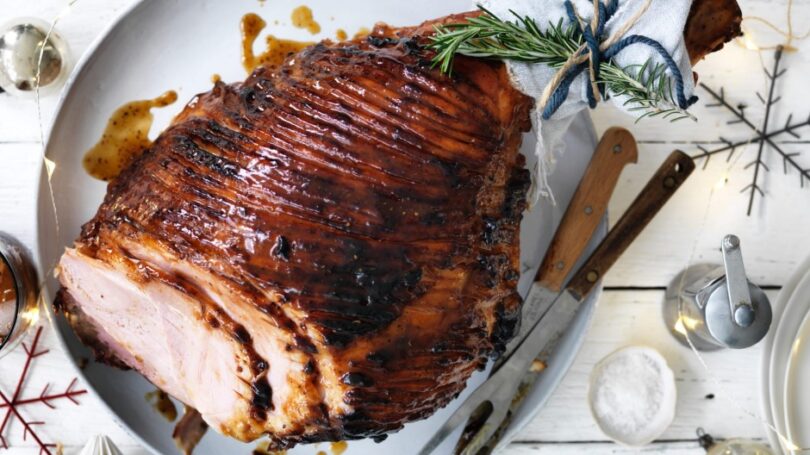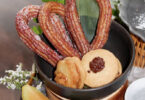Richard Cornish
Main attractions
How big a ham should I buy for Christmas? P. Janowski
It’s best to go a little overboard and not skimp on ham as this is a feast day. With a trimmed, boned ham, allow about 150 grams of ham per person. If you’re ordering ham on the bone, you need to consider the weight of the bone, skin and fat, which most people find unappetising. So calculate about 220 to 250 grams per person, depending on their appetites. These are minimum figures only, and a lot of families love a big ham on the bone. These will last up to two weeks in the fridge. Meat carved off the leg and wrapped tightly will freeze for six months.

How long will a leg of ham last after it has been cut open? P. Harper
In the Paul Kelly song I Can’t Believe We Were Married he writes: “We danced in the kitchen on Boxing Day/I held you swaying in my arms to Marvin Gaye/our Christmas ham turned green by News Year’s Eve/we weren’t hungry anyway.” Large, smoked and salted, Christmas hams are expected to last for weeks after the big day. They would have in the days before refrigeration. Back then the preservation of ham involved a lot more salt, much heavier smoke and the use of saltpetre. To many of us those hams would be unpalatable – imagine a salty, smoky, sloppy prosciutto. The New South Wales health authorities suggest a ham will keep for several weeks in the fridge. Tony Rapone from Bertocchi Smallgoods says, “If the ham is wrapped in a tea towel moistened with water, a tablespoon of vinegar and lemon juice, then placed into a clean old pillowcase, and stored in the coolest part of the fridge, it will keep for over a week.”
We are having crayfish for Christmas. How do I kill it humanely? P. Baxter

What southern Australians call crayfish, the RSPCA, and almost everyone else, refers to as southern rock lobster. It recommends rendering the animal insensible in a freezer. The length of time will depend on its size. They go limp when they are insensible. Kill the animal using a large knife and cut in half lengthways starting at the head, then thorax and finally tail.
I am buying a side of smoked salmon for Christmas. How should I slice it? L. Ling
Freshly sliced smoked salmon tastes better than the pre-cut stuff. When you cut the flesh, the smoke aroma dissipates and the fat in the salmon starts to oxidise. To slice a side of salmon, place it on a board. Assuming you’re right-handed, place the head end or thick end to your right, skin side down. Remove any small bones by feeling along the flesh for bones and gently pulling them out with fish tweezers or needle-nose pliers. Take a very sharp, long knife and, starting near the tail, cut along the flesh with the knife held almost horizontal, sawing gradually down towards the skin at an angle. Cut away the slice of flesh just before you reach the skin. Remember if you can’t see the knife through the fish flesh, you’re cutting it too thickly. You can hold the fish steady by gently placing your left hand on the thick end. It feels clumsy but it is safe. The first slice is generally not served as it is toughened by the smoke. Continue to slice towards the head end using short knife strokes and very little pressure. Some prefer to trim the dark flesh from the bottom of the slices. Arrange slices on a plate and serve with horseradish, perhaps some small capers and a little very finely chopped onion, on blinis with creme fraiche and dill, or in one of goodfood.com.au’s 125+ smoked salmon recipes.
Further correspondence
On slicing salmon one reader wrote, “I was shown by a Hasidic Scotsman at Blooms in Brick Lane to always slice smoked salmon long and horizontally. Gives a different and, may I say, wonderful melt-in-the-mouth experience. Counter-intuitive but very good.” Smoke salmon master Tom Cooper, however, recommends cutting smoked salmon vertically to make little morsels of fish that sit perfectly on the tongue.
Where can I buy goose for Christmas? M. Lockett

Geese lay their eggs in spring. They raise their goslings over summer and then, like many of us, gorge before the onset of winter, piling on layers of fat. In Europe, geese were harvested at the end of autumn for their fat, which was traditionally used in cooking, particularly baking, as well as preserving. Some geese were held over and fattened further for a Christmas meal. In Australia, a real, fresh Christmas goose will be a young bird. Some larger birds sold as goose are actually muscovy ducks. You can find mature, fat, frozen geese that are more the real deal. Try Feather and Bone in Marrickville, NSW, or John Cesters Poultry at the Prahran Market, Melbourne. .
I am hooked on Downton Abbey and wanted to make an Edwardian Christmas dinner. What should I serve and where should I get recipes? M. Fuller
Well you’ll need to prepare four different meals. For breakfast, ask the staff to make some boar brawn, kedgeree and eggs; chicken; duck; swan and quail. Naturally, then you’ll stroll about the estate, probably shoot something, before returning for a light lunch of Christmas pie filled with pigeon, pheasant, goose and foie gras washed down with a madeira. For afternoon tea at four you could have some mince pies followed by a brisk and athletic romp with one of the downstairs staff to build an appetite for a hearty Christmas dinner. This could include turtle soup, more eggs, some salmon from your river, roast turkey, plum pudding and Stilton. You could try The Unofficial Downton Abbey Cookbook by Emily Ansara Baines, but cookbook expert Tim White from Books for Cooks suggests going to the source material, such as the Edwardian edition of The Book of Household Management by Mrs Isabella Beeton, edited by Charles Herman Senn, or Senn’s Century Cook Book. He also suggests a reputable spinoff from the Upstairs Downstairs TV series called Mrs Bridges’ Upstairs Downstairs Cookery Book. White says Edwardian cookery was the height of British cooking and after World War I, when the men were buried at the Somme and all the estates were sold off, there was a turn to bedsit cookbooks and meals for one, epitomised by Lady Agnes Jekyll’s Kitchen Essays (1922), which included solitary dining pieces such as “Tray Food”.

Talking turkey
How do I know my turkey is done? C. Sheng
This reminds of the scene in HBO’s The West Wing when Martin Sheen’s President Jed Bartlett is on the phone to the Butterball hotline to find out how to cook his Thanksgiving turkey without giving his family food poisoning. The woman at the other end of the Butterball hotline says, “The two main bacterial problems are salmonella and campylobacter jejuni”. She recommends that President Bartlett cook the raw ingredients for the stuffing to 165 degrees Fahrenheit (74C) before stuffing the turkey. Bartlett shows off his knowledge of USFDA requirements for the turkey to be cooked to a minimum internal temperature of 180F (82C). The operator questions whether the President has an accurate meat thermometer. I was reminded recently by the caring team at Australia’s Food Safety Information Council that if you’re cooking a turkey – particularly if you’re unfamiliar with the process and have elderly or pregnant guests – that you should use a meat thermometer, inserting into the thickest part of the thigh for several seconds, to see if has reached the temperatures above.
How do I cook the Christmas turkey so it doesn’t end up dry? A. Garfield
You could consider one of the “fresh whole” turkeys you can find in supermarkets that contain 94 per cent turkey. Fancy that! The other 6 per cent is made up of diphosphates, polyphosphates, guar gum, xanthan gum, canola oil and sugar. Merry Christmas. Esteemed British food writer Matthew Fort gives a method that cooks the bird at 61C-63C for 10 hours, then finishes it with a blast of heat to brown the skin. Most ovens can’t deliver such low temperatures accurately so it’s not something I would recommend. The best turkey I ever had was cooked by my mate Macca. He took a free-range bird, not too big, and brined it a brine made with five litres of water, 1 1/4 cups of grey sea salt and a cup of raw sugar with half a dozen bay leaves, a small handful of fresh thyme and six crushed juniper berries, which he simmered for 15 minutes and allowed to cool before putting in his turkey and keeping it overnight in the fridge. He roasted it in the usual manner. It was brilliant.

I am making traditional stuffing for the turkey this Christmas but one guest is allergic to onions. M. Brewer
Take out the onions and it’s no longer traditional stuffing. It’s 21st-century stuffing for a world with stuffed-up digestion because we’ve all been eating crap factory food. Two options: make a separate onion-free stuffing and bake it in a covered muffin tray. Or make a really good onion-free stuffing that everyone can enjoy. You need to replace the sugar (onions are about 4.7 per cent fructose) and the umami (onions are quite high in glutamic acid). First, saute some finely diced carrot and celery, a cup of each, in some butter. Season with salt as you cook to draw out the moisture. Carrots are sweet and the celery will help with the umami. Cook very slowly until very soft. Add to the stuffing. You could increase the glutamic acid with tomato paste but that would render the stuffing pink. Instead, add several tablespoons of finely grated parmesan cheese. That will add salt, acid and umami but you shouldn’t taste it too much over the fresh herbs. That onion tang? Some would suggest adding asafoetida but it is just a little too bitter and heading too far east in a culinary sense. A drop or two of truffle oil (even though I hate the stuff) will add a sulphurous note without being discordant.
Where can I get a turducken? D. Thompson

The Russian doll of Christmas treats – the turducken – is a series of boned birds delicately shoved up one other, namely a chicken inside a duck inside a turkey. It is said to be based on a Yorkshire Christmas pie, which involved a turkey, a goose, a brace of young pheasants, four partridges, four woodcocks, a dozen snipes, four grouse, four widgeons, York ham and two tongues baked in a pie. A turducken can weigh five to eight kilograms, take about three to four hours to cook and cost about $100 to $150. Try Victor Churchill in Sydney. And Peter G. Bouchier in Hawksburn Village is selling a “trio de poulet” (their classier term for turducken, with a mushroom and sage seasoning).
Gravy matters
How do I avoid lumpy gravy? R. Mitchell
I only have to hear those jangly opening notes of Paul Kelly’s How to Make Gravy and I know after another glass of red I will be in tears. “Just add flour, salt, a little red wine,” says Joe to brother Dan, “and don’t forget a dollop of tomato sauce for sweetness and that extra tang.” Worse, perhaps, than a lump in the throat is lumpy gravy. Gravy should be made in the roasting pan. Pour off most of the fat and set it aside. Deglaze with wine or stock or both, working the baked-on brown bits with a wooden spoon. Pour off the deglazing liquid and reserve. Add some of the fat set aside from the roast and an equal volume of flour to the pan, bring together over a low heat and cook the flour until it takes on a nutty aroma. Add the reserved deglazing liquid, a cup for every tablespoon of flour, a little at a time, incorporating it slowly and taking the pan off the heat if it thickens too quickly. Mix constantly, check for seasoning and pour over everything on the plate to make it all taste the same. Remember, instant gravy is evil at the best of times and sacrilege on Christmas Day. Check out the gravy recipes and tips from The Paddington and Northern Git.

Where can I buy Parisian Essence for my gravy? I used to buy it at the supermarket but when I asked for it they said they had never heard of it. A. Irish
At a supermarket recently I was astonished when the person manning the checkout needed assistance to name the vegetables in my basket. Admittedly they were all globe-shaped, but to her, beetroot, swedes and celeriac all looked the same. So I am not surprised the staff had never heard of a delisted product such as Parisian Essence. This is basically caramel in a bottle that one adds to sauces, gravies and other cooking to give a darker appearance. For gravy, if you can, roast your meat and veg in a heavy pan and save the juices, bits of roast meat and vegetables, and cook these over low heat on the stove top until deep brown, scraping the bottom of the pan frequently. The sugars in the meat and veg will not only caramelise further, giving you a dark colour, but they will also combine with the protein in what, as we have discussed here before, is the Maillard reaction. From this you can make the gravy with a lovely brown hue. If you’re desperate for Parisian Essence, you can buy it online from Queen.
What do I use instead of wheat flour to make gluten-free gravy? P. Prentice

It’s all about starch. This is the stuff that plants make to store energy. Flour is about 75 per cent starch and about 10 to 12 per cent protein. Gluten is one of the proteins in wheat flour. When you add flour to water or other water liquids, such as milk, the starch granules absorb about a third of their own weight in liquid. When you heat starch, however, it goes a little crazy and its long molecule chains unravel and intermingle with each other and trap water. This thickens the liquid. You can use cornflour instead. Look for the crossed grain logo to indicate it has been made with corn and not wheat. Use about half as much cornflour as wheat flour (follow the directions on the pack) and make a slurry with the cornflour and a little water before adding to melted butter to make a roux. You can also use arrowroot flour, tapioca starch and potato starch. Follow the directions on the pack because the molecular make-up of the starches in these flours is different from that in wheat flour.
I am gluten-intolerant but I love gravy. Can you help? D. Wilde
If you were a vegetarian and loved gravy, I would suggest instant gravy mix as most haven’t been within a cow’s moo of any roast meat — and taste accordingly. You could use potato starch to thicken the gravy, but I reckon you should probably try this: take a decent-sized chook, perhaps stuff it with a rice stuffing, season it and roast it uncovered in a heavy oven-safe pot on top of four large onions, peeled and thinly sliced, with a few fresh herbs. When the chook is done, remove and allow to rest before carving. Make the gravy by placing the pot on the stove and turn up the heat to medium and make sure the onions are well cooked. Perhaps add a little wine and any of the juices escaping from the resting chook and cook for a few minutes. Remove the herbs, check the seasoning and blend to a puree. Serve as gravy.

Safety first
I want to put some garlic and chilli in extra virgin olive oil in pretty bottles for Christmas gifts. A friend told me there could be a problem with this. D. Ward
It’s called botulism. It’s like Botox except your face doesn’t move – ever again. As well as your heart and lungs. Botulism is the often fatal, but fortunately uncommon, poisoning caused after eating food contaminated with toxin created by the bug Clostridium botulinum. It thrives in anaerobic, or air-free, conditions such as raw food stored under oil. It is possible to store food under oil if the food is under pH of 4.6, which is very strongly acidic. Alternatively look up recipes for sott’olio, an Italian method for preserving under oil in which vegetables are dried and salted, covered in oil and pasteurised. Best not to poison people at Christmas, no matter how much you feel like it.
We are planning a big family Christmas with everyone bringing a plate. Some of my in-laws are a bit “cowboy” when it comes to food handling. What can I do? K. Lloyd

Grab the reins and guide your filthy extended family to a gastro-free yuletide with these tips courtesy of the Food Safety Information Council. Plan ahead – guests travelling more than an hour should bring low-risk foods such as pudding, mince pies and brandy. Or VB. Cook the chook and turkey on site – don’t let it travel for hours on the Chrysler’s parcel rack in the sun while they’re stuck in traffic. Keep hot items hot (perhaps in the oven turned to just below 100C). Keep cold items cold – below 4C. Save the fridge for the seafood, meat and sauces and so on and put the grog on ice in an attractive bucket, sink, bath or the bucket of a front-end loader, depending on the number of guests and your social status. For more and slightly more sensible advice, head to Food Safety Information Council.
I love nuts on Christmas Day but we have a grandson with a nut allergy. Any nut-like alternatives? G. Symmonds
I could suggest soy chips, edamame, fried fava beans or Japanese rice crackers but these are all a bit downmarket and even industrial for Christmas Day. Christmas Day is all about the build-up and the reveal – like cracking open a walnut. What about beautiful small things that can be unwrapped such as individual nut-free nougat? The best little chocolates? Hand-made cheese twists wrapped in cellophane? Whatever it is it needs to be something shared, passed around and enjoyed together.

Plum pud advice
Why are there no plums in the plum pudding? L. Virgona
Christmas pudding is one of the few remnants of medieval cooking we still have in the modern kitchen. It, along with blancmange and haggis, would be recognised as good tucker if taken back to the dining table of King Richard III. Up until the Victorian era, plum pudding was made with dried plums (prunes). As dried vine fruit from Europe became cheaper, plums were exchanged for currants, sultanas and raisins. You can make a medieval-style pudding by simply substituting part or all of the dried vine fruit for plums and upping the spices. Chefs in the 1400s were very heavy-handed with nutmeg and cardamom.
I am making Christmas puddings. A friend told me to remove the greaseproof paper and replace it with fresh greaseproof paper before storing in the fridge. G. Cullen

You could do that. And you could wish everyone “happy holidays” while you’re at it. Making Christmas pudding with the family is one of thelast festive rituals left to us. The aroma of fruit soaking in brandy, the house filled with fragrant spices, the nuggety little bowl sequestered in the linen cupboard for months to let it age. Leave the double layer of greaseproof paper on the pudding as it forms a seal against air. Also – make a small disc of greaseproof paper on the inside bottom of the pudding bowl as this stops the pudding sticking to the bowl. I simmer the pudding with the bowl sitting on an enamel saucer to avoid the bottom of the bowl getting too hot and the pudding getting too dark.
I used a supermarket-brand ground cinnamon to make my Christmas pudding this year and it tasted different. Why? B. Gillham
One of my bugbears is the substitution of true cinnamon, made from the bark of the Sri Lankan cinnamon tree Cinnamomum verum, with the bark of a cheaper close relative, the cassia tree, Cinnamomum cassia. Cassia bark is thicker, coarser and the ensuing ground spice, known as Dutch cinnamon, baker’s cinnamon and even bastard cinnamon, has a bitter aftertaste. Ask the store manager for a refund.

Can I boil coins in my Christmas pudding? T. Trewin
In the months leading to Christmas 1966 the nation was thrown into turmoil. For generations, Australians had steamed their Christmas puddings with sixpence and thruppence embedded. But with the change of currency to decimal in February that year, Australians were worried about poisoning their families with the new-fangled coins. That year, the Copper and Brass Information Centre announced “another age-old custom is being threatened!” It went on to state that the new five and 10-cent coins could “be inserted into Christmas pudding just prior to serving but they must not be cooked with the pudding”, or they would turn green thanks to the copper and nickel in them. The CBIC was far more concerned, however, with the larger size of the new five-cent piece: “The throats or stomachs of small children may not be large enough to accept the five cent coins.” So if you want coins in pudding, insert pre-decimal currency. And boil it first, my grandmother would say. “You don’t know who has been touching it.” You can buy pudding packs of sixpence, shillings and tuppence from coin dealers. Try the Perth Mint.
I have made an old family traditional Christmas pudding in a rag and am not sure how to dry it properly. L. Jones
I would hazard a bet and say you are from Queensland, as many east coast Australians refer to the fabric around a pudding as a “pudding cloth” but Banana Benders use the term “rag”. I once ruined a Christmas dinner with a mouldy boiled-in-the-cloth pudding because I didn’t let it dry properly. Since that day, I have returned to the family tradition of using a ceramic bowl. Michael Jameson, of Pudding Lane in Newcastle, says the trick to drying the puddings is to hang them as soon as they leave the pot. While an 800-gram pudding might take just 24 hours to dry, a larger pudding can require a week or so. Jameson says it is important that the atmosphere where you dry the pudding is not moist, so avoid areas such as kitchens, bathrooms and laundries. “Many people hang them under the eaves of the verandah,” he says. “Then there are those who cheat and dry them with a hair dryer.” The most important part of a pudding in a cloth to get dry is the neck where they cloth is gathered, as this is quite thick and can remain moist. After that, store it in a cool, dry place or, if you’re in the tropics, try the fridge.
I don’t want my children to have alcohol. Does all the alcohol burn off during cooking? J. Patten
No. If you pour brandy into a pan and let the evaporating alcohol ignite from the gas burner you’d be surprised to find that up to 75 per cent of the alcohol can remain in the food. Add alcohol to the end of the cooking process and you’re going to evaporate just 10-50 per cent of the wine off. Even the long, slow simmering of an alcohol-laced dish will leave you with about 5 per cent of the original amount of alcohol remaining in the dish.
I’m going to use my mother’s Christmas pudding recipe, but it calls for suet. Is there an alternative I can use without compromising the texture or flavour? K. Keane
You could try fresh unsalted butter that has been frozen then grated – but this leaves a slight greasiness that suet doesn’t give. You could try vegetable suet, an ingredient that gained popularity with the British during the mad cow disease crisis, and is made from vegetable oil, wheat starch, sunflower oil and pectin. Buy it online at bestofbritish.com.au. Suet is the fat that surrounds a cow’s kidneys. There is nothing that comes close to the rich succulence, ethereal lightness and delicate hint of renal aromas that suet gives to a dish. Remember that recipes such as your mother’s evolved with suet, its particular melting point and the way its fat works with the starch and sugar. By substituting suet for another ingredient you are changing the character of the end product – a bit like watching Hamlet with the lead played by Kenneth Williams instead of Kenneth Branagh.
Can I make a Christmas pudding without suet? F. Mallin
Goodness gracious me! You’re still making pudding with suet? Where do you get it? The pale fat surrounding beef kidneys makes incredibly good puddings but many people can’t stomach the idea. You can use vegetarian suet, made in Herefordshire, Britain, called Atora. You’ll find it online. Unsalted but not cultured butter is my preference. Make sure it is ultrafresh because the cooking and storing of the pud will exacerbate rancid odours in tainted butter. Suet is pure fat. Butter is 85 per cent fat. So add an extra tablespoon or so of flour to absorb the extra water you’re adding from the butter.
I had to buy my suet for my Christmas pudding in a 1 kilogram lot. I now have 750g left over. What can I do with it? S. Christoe
You are a very lucky person. There are people who dream of having so much animal fat in their possession. In our brave new, risk and fat-averse world, however, having that much fat in the home could render you a pariah in some nicer suburbs. Suet – the fat surrounding beef kidneys – creates a lovely texture in baked goods and puddings. Firstly, don’t eat it all at once. Secondly, if you’re not going to use it soon, cut it into three, wrap in plastic film and freeze. Grate chilled suet and use as one would butter in shortcrust pastry. You will need to add a little water, as suet does not contain water like butter does. Or perhaps chop the suet into rough cubes, place in a saucepan with a little water over a low heat and slowly melt the fat out of the suet to make the most pure dripping in which to fry potatoes. Consider, however, making a Sussex Pond, in which a lemon and sugar are encased in a suet pastry and steamed in a bowl for several hours. During this time the lemon peel candies and the sugar caramelises, creating a rich, sweet sauce that oozes from the pudding to form a pond in the bowl when opened. A few currants inside the pudding before steaming will transform it into a Kentish Puddle Pudding.
Festive baking
I made a Christmas cake and the fruit sank to the bottom. H. Kelly
Dust the fruit in a little plain flour, gently fold into the batter and bake as normal. The flour pulls water from the batter and creates “drag”, slowing the downward motion until the batter sets in the oven.
I am baking my first Christmas cake. Do you have any tips for a beginner? K. Elliot
Sorry, no. I am a pudding man. So instead we are going to paraphrase the late, great Dorothy Floate’s Secret of Success. Do not butter the tin but line it with three layers of lightweight paper. Do not use newspaper as the newsprint leaches into the batter. Butter must be cold and firm. Do not use very fresh eggs. You don’t have to use brandy or other spirits; you can use the juice from stewed fruit such as apple or rhubarb. To quote Mrs Floate, “I am repeatedly asked by worried housewives and many young girls … why their fruit cakes go down in the centre.” This is caused by the evil of overbeating the butter and sugar as the extra air trapped in the batter expands and rises. Importantly, she suggests using the very best ingredients. Although there is no mention of immigrants in her book, I personally recommend buying dried fruit and nuts from busy Middle Eastern grocers who have a high turnover of stock, or buy from fruit growers at farmers markets.
Is there an advantage in creaming the butter and sugar when making Christmas cakes as opposed to “all in together” recipes? S. Robb
For the past 20 years or so my sister-in-law has baked the Christmas cake. She lives in Los Angeles now and they don’t celebrate Christmas there. It’s too fattening. They have Happy Holidays instead, which is Christmas stripped of any offensive religion and only the shopping frenzy left. I do miss her cakes. As discussed before, creaming butter and sugar dissolves the sugar and slightly leavens the cake but overbeating can lead to a batter that won’t suspend the fruit. So some recipes are developed to have an all-in-together method that uses melted butter. The trick with Christmas cakes is to keep the fruit plump and intact. This means that no matter which stage the dried fruit is added, one has to be gentle with it so as to not break the skins, which leads to an overly moist and dense cake without any succulent fruity morsels.
Why do gingerbread recipes call for ground ginger, not fresh ginger? N. Cooke
There’s a line in Leonard Cohen’s Suzanne that goes, “And she feeds you tea and oranges / that come all the way from China”. Those words, for me, always exemplified the special, precious nature we impart to goods that arrive on the waves, but also the great value we place on them when passed on by someone significant. Gingerbread, made with dried bread, honey and spices, has its roots in medieval cookery. Fresh ginger would never have lasted the journey all the way from India. It arrived preserved in sugar or dried and powdered. Carried on the backs of pack animals by foreigners with different languages, cultures and even skin colour, the exotic narrative of the origin formed part of the spice’s allure, like an early form of marketing. Over the centuries the recipes have changed but the taste for ground ginger has remained.
A recipe for Italian panforte calls for citron. What is it and where can I buy it? M. Davison
Panforte recipes often call for candied citron, a fragrant citrus fruit (Citrus medica) with quite thick but very aromatic peel. If you planned to candy the peel using fresh fruit, you may find it quite difficult to find at this time of year. And if candied or glace citron is unavailable where you normally buy dried fruit, use another good quality candied citrus peel, such as lemon, orange or grapefruit.
Can I use real cherries instead of fake glace cherries? B. Clendinnen
I think the glace cherry makers of this world would be deeply offended if they heard you referring to their cherries as being fakes. Glace cherries start off being real cherries (see, now you have me doing it as well) – “fresh” cherries, rather – that are blanched and soaked in a sugar syrup. The moisture inside the cherries is drawn out by the sugar solution and in turn the cells of the cherry are filled with the sugar solution. Think of it as embalming for fruit. Glace cherries are so full of sugar almost nothing can live in or on them. So if you’re decorating a cake that will be eaten fresh, you can substitute glace for fresh cherries. Do not, however, use fresh cherries in a recipe that calls for glace cherries if the end product will sit around for days or weeks, such as a Christmas cake, as the fresh cherries will go off.
Courtesy: goodfood







